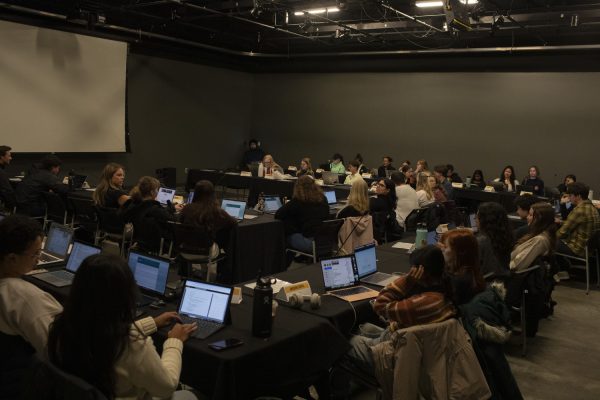UI professor uncovers complex evolutionary history of crocodylia
Christopher Brochu, a UI professor of earth and environmental sciences, has uncovered more of the East African crocodilian family tree with colleagues from Stony Brook University. The collaboration could uncover important climate-change trends as unnamed species are discovered.
A collection of specimens from the evolutionary order crocodylomorphia at Trowbridge Hall on Feb. 13.
February 18, 2019
UI earth and environmental sciences Professor Christopher Brochu’s office shows his passion for his research simply by its contents: books stacked high, papers scattered across his desk, and photos of crocodilians — the world’s largest living reptiles.
Brochu has committed the rest of his career to unveiling the evolution of these previously misunderstood creatures, he said.
He collaborated with two UI graduates in a recent analysis published in the journal Scientific Report. Both colleagues are faculty members at Stony Brook University in the Department of Anatomical Sciences. Associate Professor Alan Turner graduated from the UI with an M.S. in 2004, and Assistant Professor Eric Wilberg earned a Ph.D. from the UI in 2012.
The three have long worked together, and the recent study evolved from Wilberg’s work as a graduate student at the UI.
RELATED: Assistant professor earns $2.1 million to continue research on the cerebellum
Crocodilia is an umbrella term relating to crocodiles, alligators, caimans, and gharials, Brochu said. For many years, it was believed that these creatures evolved slowly. Brochu and his team, however, believe differently. They are uncovering the complex family tree of crocodilians in East Africa.
“In general, my research program is directed toward resolving the evolutionary relationships and diversity of living and extinct crocodilians,” Brochu said. “One of the things I’ve encountered is the assumption that they were living fossils and haven’t changed since the dinosaurs. Their evolutionary history is just as dynamic as any other group.”
One of the things I’ve encountered is the assumption that they were living fossils and haven’t changed since the dinosaurs. Their evolutionary history is just as dynamic as any other group.
— Professor Christopher Brochu
Brochu and his colleagues’ research is unique in the field, and not many other scientists are devoting projects to this topic in East Africa, he said. Brochu believes that because of this, there is enough to study to occupy the remainder of his career.
Brochu began with an interest in paleontology, but the diversity of crocodiles caught his attention in graduate school. He first visited East Africa in 2007, he said, and discovered a number of unnamed crocodilian fossils.
He noticed that many scientists do research in East Africa because that’s where humans originate from, he said, but most are focused on mammals. Hardly anyone has researched the crocodilians.
Brochu will return to Africa this summer with Ph.D. student Amanda Adams to try to give a name to the unnamed species.
“The more we learn about those small changes and little evolutions, there’s evidence that now there are more species,” Adams said. “It’s really important when we talked about conservation.”
Scientists recently believed that there are only a handful of different crocodilian species, Brochu said. The more research is done, the more species are being uncovered.
Uncovering the family tree of these animals is important in understanding climate change, C.T. Foster, the chair of the Earth and Environmental Sciences Department, said in an email to The Daily Iowan.
“This kind of research, which involves both geology and biology, is important because it allows us to understand how animals respond to various types of climate and geologic changes during the Earth’s history, and conversely to use evolutionary responses to infer basic information about the nature of these changes and how they have affected the environment,” Foster said.





















